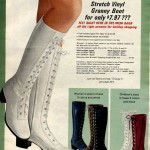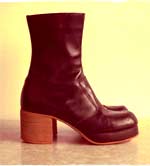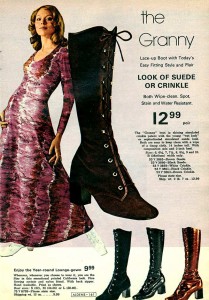
Boots reached the height of their fame in the early 1970s. Not only did women have a boot for every occasion, but the unlimited varieties of boots that were produced in the seventies was unparalleled. As you can see in the pictures we have posted below, they came in all shapes and sizes.
Obviously dancing boots, later called Go-Go boots, complimented the short skirts and dresses of the 1960s.
Nancy Sinatra certainly didn’t hurt things with her hit song, “These Boots Are Made For Walking.” The rising boots trend didn’t stop at the end of the sixties.
No color or pattern was off-limits. One woman could be seen wearing purple suede thigh-high boots, while the next woman is wearing white vinyl stretch patent boots, complete with faux diamond studs and 3 1/2 inch heels.
Boots were so popular in the early 1970s that even men were getting in on the action. It wasn’t uncommon to see a man sporting 1-2 inch platform boots.
Like almost all other aspects of fashion in the late 1970s, boots also calmed down and lost most of its flamboyancy.
Brown leather boots — with a short heel — that zipped up the side was the smart choice in 1979. By that point boots were still popular in the winter, but their popularity had cooled off substantially.
Fortunately, designers gave boots all different kinds of creative names like crinkles, platforms, knee-highs, The Granny, stretch boots and more. Let’s cover them in more detail below.
Crinkle Boots

Crinkle patent stretch vinyl granny boots (1971)
In 1970, the “wet look” was very popular. It was mostly achieved with shiny vinyl that had a bit of texture to it. The texture gave it a crinkled look, hence the name “crinkle boots.”
The word crinkle more refers to the look of the boot and could be combined with any other style of boot. You could have crinkle stretch boots. They also made crinkle knee-highs.
Mostly, if the boot did NOT have a smooth texture and had a purposefully wrinkled design, then you could called them crinkle boots.
Platform Boots

1970s platform boots
When we talk about platform boots, we are talking about the heel and sole of the boot. Exactly like a platform shoe, the platform boot has an exaggerated sole — sometimes up to four inches tall.
1970s platform boots also had a heel that was a little more modest. Pretty much any other type of boot could have platforms. While they may have made some women feel an inch or two taller, they were mostly worn for an extra splash of style.
Granny Boots

Granny Boots (1972)
In the 1970s, “Granny” boots were called this because they were ripped straight out of the 1920s. Before fashion designers started reproducing these boots in the 1960s, women were stealing them from their grandmothers’ closets.
However by the late sixties, new bohemian styles and patterns were beautifully added to the old fashioned boot to create something totally new and wonderful. The trend continued strong into the seventies.
Granny boots are pretty easy to identify. They lace up the front and usually stop just below the knee. They can come in any color or material, and have a heel, either chunky or slender.
The 1920s style granny boots usually have a more slender heel than the ones from the 1970s.
























































